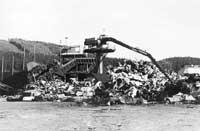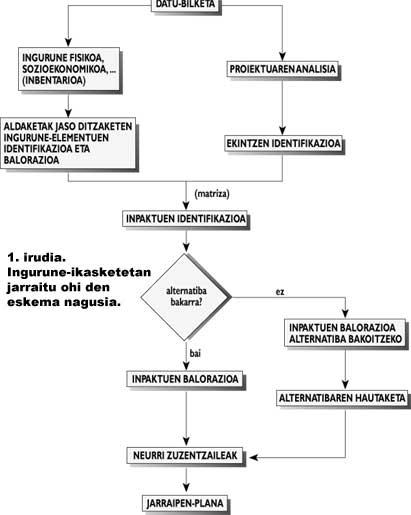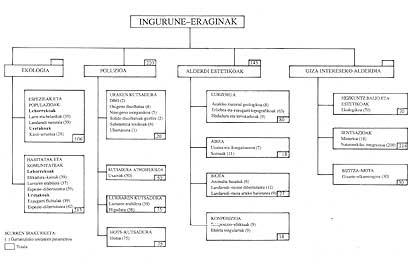Environmental impact assessments: who, to whom and what
1995/10/01 Sarasua Garmendia, Asier Iturria: Elhuyar aldizkaria

The construction of the Leitzaran motorway, the marina of Plentzia or the reservoir of Itoiz, as well as visits to the supermarket, mountain outings on weekends or domestic water consumption also have something in common. Although in fact they are very different, all the activities mentioned represent a change in what we call “environment” and in most cases, when this happens, the local environment is away from its original characteristics.
However, special care must be taken to determine whether or not change has occurred, as systems undergo variations over time. When it is recognized that change has occurred, regardless of its sign, it is said that an environmental impact has occurred. The Environmental Impact Assessment (EIA) is a tool created to define the characteristics of the impact and make its impact minimal.
Throughout the 1980s, the debate on problems such as the reduction of the ozone layer or the greenhouse effect caused a certain “environmental revolution” that made industrialized countries realize the need to act to alleviate the aggressions suffered by the environment, even though they did not have clear their role. In this sense, environmental impact assessments were created as a methodology to evaluate any human action. The following lines will analyze its main characteristics.
From: author
The assessment of environmental impacts is divided into two sections: Study of Environmental Impacts, that is, set of works aimed at the prevention of environmental effects of activity and the implementation of corrective measures and Declaration of Environmental Impact. The latter is the administrative procedure that will make public the environmental “goodness” of the activity, which includes public participation.
The Law requires that it be presented by the owner of the Environmental Impact Studies Project and based on it, the Administration will carry out the Environmental Impact Declaration. This Order is one of the most serious problems in the assessment of environmental impacts, since the fact that the project promoter and the author of the environmental assessment are the same person, conditions the objectivity and effectiveness of the work. Good development of environmental impact assessment can be subject to economic interests and in practice is almost always.
A

When it comes to defining the projects that require the application of environmental evaluation, there are great debates. Most technicians consider that the list of activities that are required to conduct an environmental impact assessment is too short, as the legal criteria are limited to a few giant projects. Currently the list consists of the following projects: oil refineries, thermal and nuclear power plants, toxic and radioactive waste deposits, integral steel and chemical plants, asbestos constructions, highways and highways, long haul railways, airports, commercial and sports ports, large reservoirs, first repopulations (when there is risk of serious negative ecological transformations) and clear sky extractions.
As can be seen, other significant projects are excluded, such as industrial polygons or the variants that have proliferated in recent times, which due to their abundance represent a more important global impact and which should be taken into account. In this sense, there is an important awareness of some public institutions that have begun to take into account the impacts of the public constructions they promote.
What: Phases of Environmental Impact Assessment
The constructive process of environmental impact assessment has in all cases two main points of departure or pillars: the physical and social environment and the project. The first is understood in its broadest sense, that is, all those environmental aspects that can be affected by the actions included in the project, from fauna or geology to the social or artistic environment. These are divided into three categories: biotic aspects (vegetation, fauna, habitats,...), geotechnical aspects (geology, hydrology, climate, edaphology,...) and anthropic aspects (economy, demography, heritage,...).
Taking into account legislation on environmental impact assessment, the project is as follows: “The execution of plans or programs, the execution of buildings or other installations or works, such as other interventions in the natural environment or in the landscape, including those aimed at the exploitation of renewable and non-renewable natural resources, in particular any technical documentation that defines or conditionally their location, all within the framework of the actions contained in the annex to Royal Decree 1131/88 of 30 September”.

The Decree suggests the prior drafting of the project to carry out the evaluation of environmental impacts, and doubts may arise when deciding at what time of the process the evaluation should be carried out. It would be desirable to carry out an analysis of the environment and decide what would be the most appropriate location of the project in its role, but in practice often the opposite happens, since the project is first drafted and then the evaluation of environmental impacts is carried out. Therefore, the evaluation depends on the activity to be evaluated. But for the evaluation to be effective it is necessary to apply it in all phases of the process, from the mere idea to the completion of the construction works and the implementation of the follow-up plan.
The first step in assessing environmental impacts is the collection and analysis of data relating to the physical environment and the project (Figure 1). The project is informed by the owner and information about the environment is obtained mainly in the administration (Basque Government, Provincial Council, City Council). Obviously, most of the information is provided graphically (in the form of cartography and graphic representation) and the most important section of the evaluation is done.
Once all the data is collected, the activities that may have an impact within the project and the components of the environment that may be affected are identified. These are given a value that is then related to an array. Although other evaluation methods may be used, matrices remain the most widely used. As a result of the experience of several years, it has been concluded that each type of activity generates similar impacts, matrix models have been developed that define all impacts.
When the evaluation is applied at an early stage of the process, there is a possibility to decide which of the two or three alternative activities is best suited. In this case, once the impacts are identified, they are valued, individually and for each alternative, from the function of the characteristics of change that affect the environmental elements initially analyzed. Significant effects and minimal effects are then distinguished, although only significant ones should be mentioned in the study of environmental impacts, which will be characterized by the valuation criteria established in the law. Based on valuation, the most environmentally viable alternative (at least theoretically) is chosen. In most cases, however, we must work with a single alternative, since the selection has been made previously. In this way, the assessment of environmental impacts will aim to solve the effects of impacts, not avoid impacts.
Based on this information and depending on the degree of alteration they will generate, the impacts are classified into four groups (Table 1). It is assumed that the environmental element altered in the compatible impacts has recovered its pre-impact state. Slow corrective measures will be applied to moderate impacts. If it is a serious impact, it is inevitable, according to the law, the application of measures and when a critical impact appears, it is not allowed to move forward.

As for corrective measures, most environmental recovery experts agree to recognize their limited value. In fact, it is much more effective to avoid impacts by properly designing the project. However, there will always be an impact, so all studies in this area should include a section dedicated to this topic. The corrective measures are based on the specific characteristics of the project, but it can be said that the criteria to be followed are not yet fully consolidated, since the correction of impacts is a relatively new area. In any case, amendments should be made as soon as possible to avoid secondary impacts.
The last step in environmental impact assessment is the follow-up plan that ensures compliance with corrective measures. It analyzes both the impact and the evolution of the measures and proposes new corrective actions in case of new modifications.
Who, to whom and what
Given the current nature of environmental assessments, it is not surprising that environmental impact assessment is often a simple supplement to the project. It is reported that the presentation of the evaluation is carried out by the project owner. How will you recognize that the impact of the activity it promotes is critical if it implies the prohibition of it? Thus, all impacts will be compatible or moderate and learning will be conditioned from its origin.
Undoubtedly, the most appropriate is the learning of the territory and decide where the activity will be located in its function. Moreover, some environmental management professionals propose to conduct assessments of the environmental impacts of policies, plans and programs, as the temptation to divide an activity into sections and to conduct assessments of the environmental impacts of each section is often explained. Environmental technicians consider that a 50-kilometer highway produces a barrier effect, but if the barrier effect of a 5-kilometer highway is not taken into consideration, the fraud route will be left open. The National Hydrology Plan is another example of this problem, as reservoir and riverbed assessments will be conducted rather than analyzing the integrity of the Plan.
In order for the study of the medium to integrate all the variables that intervene in the activity, multidisciplinary groups are essential, but in the cases in which they have been given a great lack of cohesion is detected, each one realizes only the duty that corresponds to it, so in the report there are frequently repetitions, incoherences and gaps. Much work must be done on this path.
To finish I would like to make a note. Despite all the above, the assessment of environmental impacts should still be approved as a draft that should be refined and developed in the future. In any case, it is undeniable the importance of this step in the creation of a methodology that allows the resolution of environmental problems.

Royal Decree 1131/88 of 30 September approving the Regulations for the Implementation of the Royal Legislative Decree of 28 June on the Assessment of Environmental Impacts distinguishes the levels of impact to be defined in the performance of the environmental impact assessment: Environmental impact: it is revitalized immediately after the end of the activity and does not require protective or corrective measures. Moderate environmental impact, without intensive protective or corrective measures for its recovery and with a recovery period of the original environmental conditions. Severe environmental impacts The recovery of environmental conditions requires an adaptation of protective or corrective measures and requires a long period of time. Exceeds the acceptable threshold of environmental impact. It causes a definitive loss of the quality of environmental conditions, even if protective or corrective measures are taken and their recovery is not possible. Depending on the evaluation criteria regulated by the law we have direct or indirect, simple, cumulative or synergistic impacts, in the short, medium or long term, positive or negative, permanent or provisional, reversible or non-reversible, recoverable or non-recoverable, periodic or of irregular presence and, finally, continuous or discontinuous. Table . Impact levels. |

Gai honi buruzko eduki gehiago
Elhuyarrek garatutako teknologia






